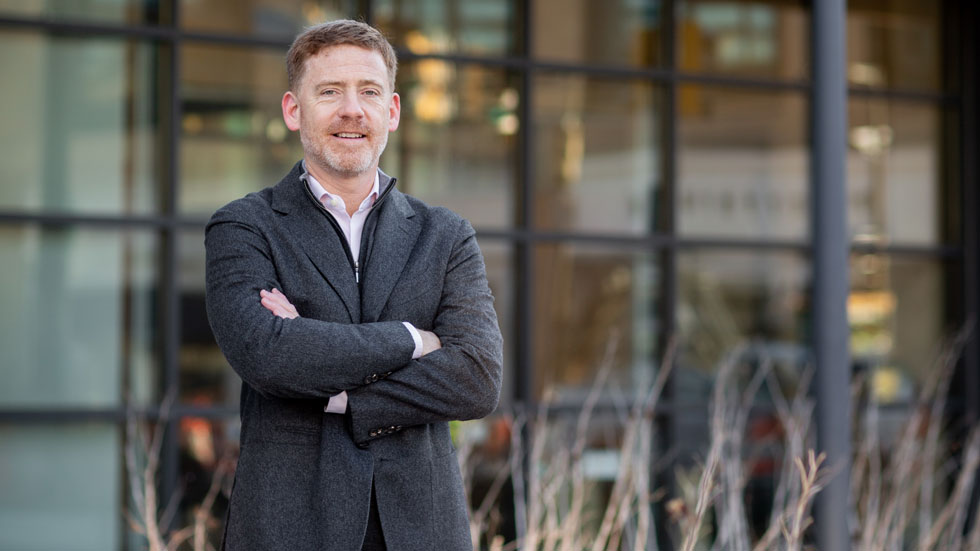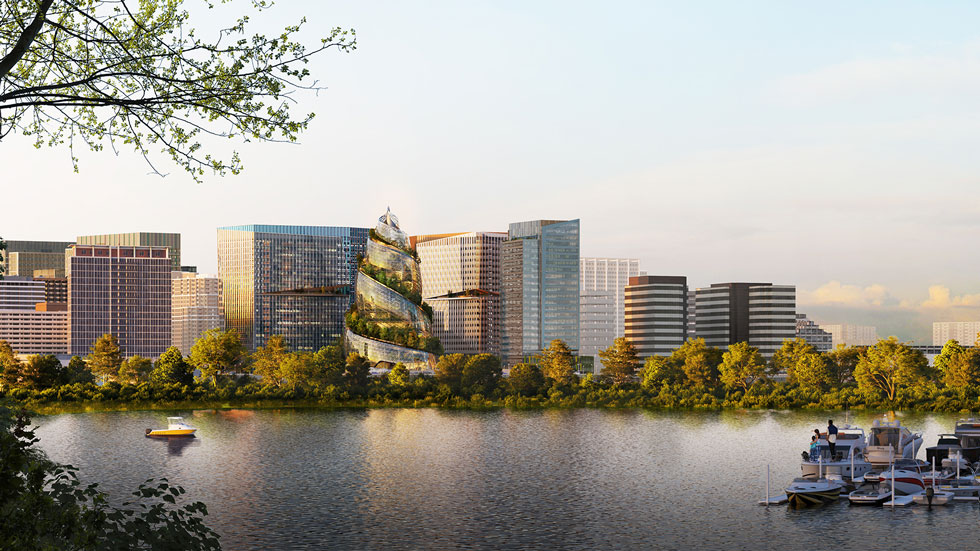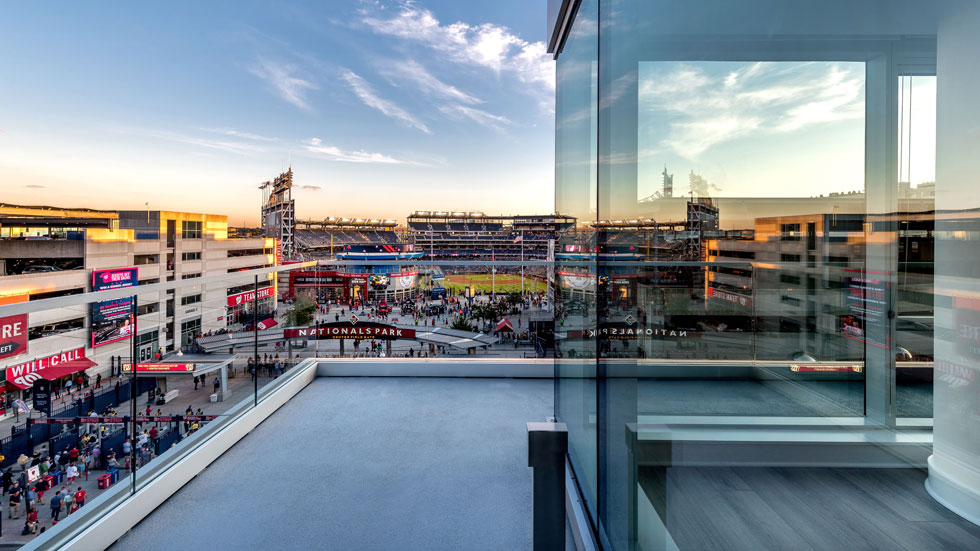As JBG SMITH develops a new, tech-enhanced neighborhood at National Landing, CEO Matt Kelly sees the REIT’s path ahead aligned with Amazon’s continued growth.
From a student job as a UPS driver to CEO of JBG SMITH (NYSE: JBGS), Matt Kelly’s career path has steered towards fast-paced environments where on-time delivery—whether packages or the latest phase of a development project—is essential. It’s a setting in which he clearly thrives.
“I’ve given up expecting that we’re ever going to have a year that feels moderate in its pace of work or energy level. The truth is, I’m not sure I would even want that,” Kelly says.
JBG SMITH was created in 2017 when Vornado Realty Trust (NYSE: VNO) spun off its Washington, D.C.-area business, Charles E. Smith, and merged it with private real estate development firm the JBG Companies, which Kelly had joined in 2004.
In late 2018, Amazon named JBG SMITH as its development partner for the creation of a second national headquarters at the Northern Virginia site now known as National Landing. The announcement ended months of speculation, and fast-forwarded JBG SMITH’s existing plans to reposition a submarket that, although strategically located across the Potomac River from Washington, D.C., had seen years of under-investment.
Going forward, the REIT’s partnership with Amazon will be a central element of its strategy and key to its success. Kelly spoke with REIT magazine about his vision for the National Landing project, as well as the value of affordable housing, the importance of placemaking in a post-COVID world, and why you shouldn’t back up a delivery truck too fast.
Looking back, was there a student job that made an impression on you in terms of the lessons it imparted?
It’s interesting to answer that question now because we recently moved my mom out of her home and came across about 12,000 photos. Among them was one of me in my brown UPS uniform. It was a job that was very hard to get. They interviewed a lot of people and didn’t hire many, plus you had to be 21 and have a commercial driver’s license.
One of the things that really struck me was that everybody I encountered in that job was just as ambitious and type-A as the people I’ve encountered later in my career—the only real difference was what circumstances they were born into. It reminded me of just how fortunate I was, with the access to education and other opportunities that I had.
For many people, that’s the key difference, and so it was important for me to really do everything I could not to waste any of those opportunities. My dad is an immigrant and he always told me that the one thing nobody could ever take away from you was your education. It really is true, but there’s nothing like seeing it firsthand.
Obtaining a commercial driver’s license must have involved some challenges?
Yes, you have to learn about things like off-tracking and you quickly discover that if you back the truck into a loading dock too fast you could spend an hour picking up all the packages that had been so carefully organized for delivery by zip code. So you learn how to get that right.
At what point did real estate come on your radar?
It wasn’t until I went to business school and it really had everything to do with the people that I met who had been in the real estate industry prior to business school. Before that time, I had worked mostly in financial services, starting at Goldman Sachs followed by a private equity firm, Thomas Lee Partners, in Boston. I then co-founded a software firm, so I had not really been exposed to real estate at that point. Of course, this was 2003, 2004 when real estate was becoming more sought after, so there were more people coming from real estate into business school.
Was there something special about the industry that drew you in?
I really appreciated the combination of entrepreneurialism and scrap and hustle, and also smarts. Real estate is such a relationship-driven business. I know it’s not the only business that is, and of course it’s very transactional, but people tend to stay in real estate. You form relationships that last decades, and that matters a great deal of the time. I saw it as an industry populated with people that I really appreciated and enjoyed.
Real estate, I discovered, is an industry where you could have an impact on how people live and on the built environment. There was something that really grabbed my attention.
Are these some of the reasons why you’ve stayed at JBG SMITH and its predecessor since business school?
I gravitated toward a firm that was a more active developer. We really do focus on trying to make built environments better for all the ways people use them. That’s personally very gratifying to me.
As most people know, over time your work becomes much more about who you’re working with than the actual practice of the craft. I got lucky from day one by joining a company that was already populated with a lot of really great people.
My plan had been to join for a couple of years, get some experience, and then go do something on my own. After a few years, I realized that I really loved working with my colleagues and couldn’t imagine leaving. They were always so good about giving me more and more responsibility. That approach really did allow me to thrive and do a lot in a short period of time. We try to keep that mindset going because I do think it’s the best way to keep people engaged and to retain the best people.
The last time we spoke was after Amazon announced it had selected JBG SMITH as a partner. What has been the pace since then?
It seems every year is busier and busier. Even when we think we couldn’t possibly top last year it seems to defy expectations. With the Amazon partnership well underway, we are very keen on moving the plan forward. We have a lot in our pipeline currently in various stages of development, a lot of balls in the air, but we’ll get it all done. Amazon has not missed a beat, they’ve only been hiring faster, so the need for housing and office space has only grown.
Can you bring us up to speed on what’s been happening on the ground at National Landing?
Amazon’s headquarters are under construction and we turned over the first new building, 1770 Crystal Drive, last year—early and ahead of budget. Amazon has built that out and it is ready for occupancy when people come back to the workplace. They’re investing very heavily in testing to make sure that can be done as soon as possible.
Our plans with the neighborhood remain very much on track. We’ve delivered the first phase of new street retail on Crystal Drive and we expect that will open this summer. It’s over 80% leased and we’re focused on the restaurants, bars, and operators there to make sure they’re healthy and stay in business through all of this pandemic pain. That’s the challenge in retail these days, but so far, we’re optimistic.
Entitlement plans for the balance of our development opportunities in the neighborhood have continued through the pandemic. We expect to start construction on our 1900 Crystal Drive apartment building sometime soon, and we’ve been out in the market getting pricing on that project.
We expect construction costs will come down, so that will help us. We believe the pipeline of new apartments has gotten thinner so we expect the demand picture will really look no different than anticipated when we deliver the new buildings, which will be good for the repositioning of the neighborhood.
What does JBG SMITH’s acquisition of Citizens Broadband Radio Service (CBRS) spectrum at National Landing mean for the project?
The spectrum acquisition was very much in line with our concept of placemaking, just in digital form. We wanted to make sure that high-speed connectivity and next generation infrastructure would be put in place as quickly as humanly possible. We thought that by controlling the digital real estate (controlling the spectrum), we could influence that process. And so far, we’re off to a very good start.
While the dollars may be relatively small, the impact will be sizeable. As we speak to prospective tenants looking at making significant location decisions, the number one thing they focus on is talent. Number two is connectivity and digital infrastructure. Many people take for granted that what you get in every place is the same, but it’s really not. Those places that have better fiber redundancy, faster access to data center clusters, next-gen radio communications, and 5G, will be the ones that capture the attention and the demand of those users first.
We control so much real estate that can accommodate 5G antennas, which have to be hung pretty close together in order to work properly. In many urban locations, you’d have to make deals with 30 different landlords to be able to do the same thing. We do hope to announce soon who we’re teaming up with to enable National Landing to be one of the first fully operational 5G-enabled cities in the country where innovators, tech companies, apartment renters, and commercial customers will see huge advantages to being in this neighborhood.
Placemaking’ is a key term at JBG SMITH. Do you see that concept taking on new relevance post-pandemic?
Just about everybody I know is desperate to be around other people and to enjoy the places where they used to congregate. We have a ton of open space at National Landing, which I think will be a real asset because it’s not like we’ll flip the switch and all of a sudden the pandemic will be over. There’ll be a gradual period of re-entry and open space will feature prominently in that process.
All the elements that contribute to the creation of a place are the types of things that I think people are desperately missing. I believe it will be even more of a distinguishing characteristic of successful real estate in the future than it was pre-pandemic.
What are some other JBG SMITH development projects we should be watching?
The other submarkets where we concentrate in and around the Washington metro area include the Ballpark District, the Union Market neighborhood, and the Shaw neighborhood in the District of Columbia, as well as Reston town center in Virginia, and Bethesda, Maryland.
There’s been a lot of talk about urban versus suburban lately and some of our best performing retail, as far as top line revenue and customers, has been in our more dense, urban locations down by the Ballpark, for example. Part of it is because there’s a lot of open space there to accommodate outdoor seating. We’ve also been able to get approval for certain rule amendments around outdoor dining, which have been very helpful to retailers and that I hope become permanent after the pandemic because customers love it.
Those are submarkets that I fully believe will recover very strongly post-pandemic when people feel it’s safe to gather in greater numbers and to do the things they did before. The placemaking work that we’ve already done will really make those communities thrive.
Has the recycling of assets become more challenging in the current climate?
It has, without question. Most of what we’ve been looking to dispose of have been office assets or in some cases, land assets, and those are two categories that really saw very little activity after the pandemic hit and haven’t come back yet.
The market is heavily dependent on foreign buyers and the one thing that has not gone virtual is the final decision of a real estate buyer to purchase an asset sight unseen. It just doesn’t happen. I suspect the capital markets will continue to be slow at best, but we are hoping for better conditions in the second half of this year and we do intend to get back to executing on that recycling strategy.
JBG SMITH’s Dawnita Wilson was recently recognized by Nareit for her work on diversity, equity, and inclusion. What direction do you want the company’s DEI strategy to take?
We’re very focused on, as Dawnita likes to say, walking the walk and really following through on what matters most. Our workforce is majority minority already, but we need to make more progress at the senior ranks. We have been taking steps in the right direction, but we have more work to do. Our board is one third women, and we’ve been public about wanting our board to be more reflective of the workforce and having more diversity.
Where you really measure this is when we fast forward into the future. Will we find ourselves working in an industry that is a leader, not a laggard, when it comes to representation of the greatness of our workforce throughout the ranks?
Where do you see JBG SMITH positioning itself in the next three to five years?
The top two headlines of our story in the years to come will be Amazon’s growth within and our repositioning of the National Landing market. We will put it on the map as one of the best new places in the Washington Metro area and the country for people looking for a place to live or work. We do expect Amazon’s growth to drive tremendous demand for multifamily, office, and retail in the area.
The playbook that we are formulating for the ‘smart city’ initiative will be applicable in other submarkets throughout the city. We won’t be the only ones doing it, but my hope is that we will be successful in being one of the first and that we will effectuate every layer of that placemaking strategy and that repositioning.
I also think investors will see us make good on our plans to divest office assets and redeploy that capital into more multifamily and to really shift the mix of what we are right now, which is majority office. Over time, I do believe we will become at least half, and very likely majority, multifamily with heavy concentration in the path of strongest growth in our market.
How does affordable housing fit within JBG SMITH’s overall strategy, and what might we expect in the coming years?
We recently announced another deal through the Washington Housing Initiative, which we launched in partnership with the Federal City Council in Washington, D.C. We raised a mezzanine financing fund to support the financing of the Crystal House apartments by an affordable housing nonprofit, the Washington Housing Conservancy. Amazon is putting up most of the financing. Crystal House is over 800 units of middle-income market rate housing, right in the shadow of the Amazon headquarters. With Amazon’s financing comes a 99-year covenant to maintain the affordability of those units. That’s a huge step towards preserving housing equity in the neighborhood.
I think you’ll see more deals like that, possibly with Amazon, because they have made a $2 billion commitment. That initiative will be very effective in preserving housing affordability and we intend to continue with the deployment of that strategy. When we developed the housing initiative, we initially targeted the preservation of 3,000 units in 10 years. We’ve already hit over a third of that goal in just the first two years. I think we’ll blow past our initial objective, probably in less than half the time, and that’s exactly what this market needs right now.
We have over 5,000 units in National Landing in our pipeline, which will go part of the way towards addressing the issue, but we also need to make sure that we retain housing equity within these neighborhoods. It’s one thing to build new apartments for higher end renters. It’s another thing entirely to preserve the equity of housing and housing availability in a neighborhood by maintaining the existing affordable housing stock. We know that people have a harder time keeping jobs when they have to move further away, and you can stop some of those negative cycles through preservation.



